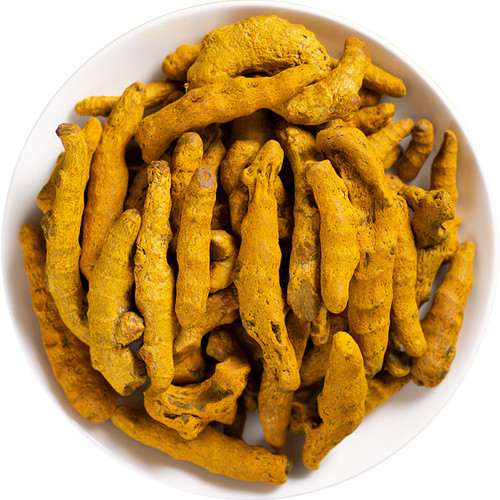Product Overview
Parts used: Dried rhizome
TCM category: Herbs that invigorate the Blood
TCM nature: Warm
TCM taste(s): BitterPungent
Meridian affinity: Spleen Liver
Scientific name: Curcuma longa
Other names: Jiāng huáng
Use of turmeric (Jiang Huang) in TCM
Please note that you should never self-prescribe TCM ingredients. A TCM ingredient is almost never eaten on its own but as part of a formula containing several ingredients that act together. Please consult a professional TCM practitionner, they will be best able to guide you.
Preparation: Wash and remove impurities, slightly soak in water, cut in thick slices and dry
Dosage: 3 - 9 grams
Main actions according to TCM*: Moves Blood and unblocks Stasis. Facilitates the movement of Qi and eases pain. Clears the meridians, expels Wind and moves Blood to relieve pain.
Primary conditions or symptoms for which turmeric may be prescribed by TCM doctors*: Chest pain Amenorrhea Abdominal bloating Rheumatism Abdominal pain Rheumatoid arthritis Irregular menstruation Gallstones
Contraindications*: This herb should be avoided during pregnancy; it should not be used when there is Blood Deficiency with signs of Stagnation of Blood or Qi.
Common TCM formulas in which turmeric are used*:
For rheumatism, muscular pains and spams or lumbago combine turmeric with notopterygium roots (Qiang Huo), milkvetch roots (Huang Qi), dong quai (Dang Gui), red peony roots (Chi Shao), saposhnikovia roots (Fang Feng), fresh ginger (Sheng Jiang), liquorice (Gan Cao) and jujube dates (Da Zao).
For Cold Wind Dampness diseases associated with headaches and arthritic and rheumatic conditions, especially of the upper back and shoulders combine turmeric with notopterygium roots (Qiang Huo) and saposhnikovia roots (Fang Feng).
Key TCM concepts behind turmeric (Jiang Huang)'s properties
In Traditional Chinese Medicine (TCM), turmeric are plants that belong to the 'Herbs that invigorate the Blood' category. Like the name indicates these herbs tend to stimulate the Blood flow. In TCM they're used to help the circulation of Blood in cardiovascular conditions or menstrual irregularities as well as to treat acute pains caused by Blood Stagnation. They can also be used to treat Blood Stasis in the case of certain tumors, cysts and hardened clots.
Furthermore turmeric are plants that are Warm in nature. This means that turmeric tend to help people who have too much "cold" in their body, although with less effect than a plant that would be Hot in nature. Balance between Yin and Yang is a key health concept in TCM. Those who have too much cold in their body are said to either have a Yin excess (because Yin is Cold in nature) or a Yang deficiency (Yang is Hot in Nature). Depending on your condition turmeric can help restore a harmonious balance between Yin and Yang.
Turmeric also taste Bitter and Pungent. The so-called "five elements" theory in Chinese Medicine states that the taste of TCM ingredients is a key determinant of their action in the body. Bitter ingredients like turmeric tend to have a cleansing action on the body by clearing heat, drying dampness and promoting elimination via urination or bowel movements. On the other hand Pungent ingredients tend to promote the circulations of Qi and body fluids. That's why for instance someone tends to sweat a lot when they eat spicy/pungent food.
The tastes of ingredients in TCM also determine what organs and meridians they target. As such turmeric are thought to target the Spleen and the Liver. In TCM the Spleen assists with digestion, blood coagulation and fluid metabolism in the body. The Liver on the other hand is often referred as the body's "general" because it is in charge of regulating the movements of Qi and body fluids. It also takes a leading role in balancing our emotions.
Use of turmeric (Jiang Huang) as food
Turmeric are also eaten as food. It is used as an ingredient in dishes such as Indian curries or Moroccan tajines.






